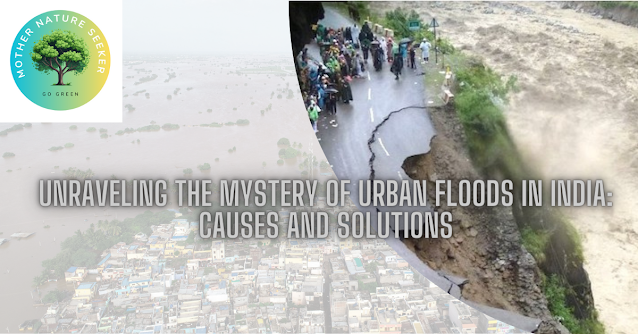Unraveling the Mystery of Urban Floods in India: Causes and Solutions. This article explores the causes, effects, and possible solutions for India's urban floods, which are a severe problem. We are also aware of the 2023 urban flooding crisis.
 |
| Unraveling the Mystery of Urban Floods in India: Causes and Solutions |
Introduction: The Challenge of Urban Floods in India
Causes of Urban Floods in India
Poor Drainage Infrastructure: Inadequate drainage infrastructure in numerous Indian cities cause waterlogging and consequent flooding during monsoon seasons.
Encroachment of Water Bodies: Unplanned urban growth frequently results in the encroachment of natural water bodies, such rivers, lakes, and ponds, decreasing their ability to hold surplus water and raising the possibility of floods.
Deforestation and Impermeable Surfaces: The land's capacity to absorb rainwater is diminished by widespread deforestation and the spread of impermeable surfaces like concrete and asphalt, which leads to rapid runoff and flooding.
Climate Change: Urban floods are becoming increasingly common and severe as a result of the intensification of rainfall events brought on by climate change in weather patterns.
Impacts of Urban Floods
Loss of Lives and Property: Urban floods cause major economic losses in addition to the death toll, infrastructural damage, and property devastation.
Displacement and Health Risks: Public health issues are exacerbated in flood-affected communities by the likelihood of displacement, poor sanitation, and an increased risk of diseases transmitted by water.
Disruption of Essential Services: Floods exacerbate the suffering
experienced by impacted populations by interfering with vital services
including water supply, electricity, and transportation.
2023
Urban Floods Incident
Devastating urban floods struck numerous major Indian cities
in 2023, emphasizing the critical need for preventive measures for
addressing this problem. Cities experienced significant flooding of residential
areas, disruptions to transportation networks, and damage to vital
infrastructure included Mumbai, Chennai, and Kolkata. The urban floods of 2023
demonstrated how important it is to include flood resilience in urban
development programs, as they served as a sharp warning of the mounting threat
posed by climate change and inadequate urban design.
Solutions
to Urban Flooding
Improved Urban Planning: Urban flood risk can be reduced by putting in place strong urban planning strategies that give priority to green spaces, sustainable drainage systems, and flood-resistant infrastructure.
Investment in Infrastructure: Cities can become more resilient to floods by making investments in the construction and maintenance of drainage systems, embankments, and flood barriers.
Community Engagement and Awareness: Communities can be empowered to lessen the effects of urban floods by receiving education about flood preparedness, early warning systems, and sustainable water management techniques.
Green Infrastructure: Encouraging green infrastructure can help mitigate urban
flooding by reducing surface runoff and absorbing rainfall through features
like rooftop gardens, permeable pavements, and rain gardens.
Conclusion
India was awakened to the critical need for comprehensive
plans to mitigate the growing issue of urban flooding by the urban floods of
2023. India can increase its resilience to urban floods and establish safer,
more sustainable cities for future generations by putting sustainable urban
design concepts into practice, investing in infrastructure, and encouraging
community engagement.
Gratitude for perusing and following for more knowledgeable data.
VISIT
THIS WEBSITE FOR COMPLETE DETAILS:
Learn
about atomic absorption spectroscopy in 5 minutes
Advantages
and disadvantages of atomic absorption spectroscopy
Protecting
the Planet: Key Environmental Issues and What you Can Do
Atomic
Absorption Spectroscopy: Applications in Environmental Analysis
The
Rarest Places Where Micro-plastics are Found: Pollution Research
Environmental
Engineering Careers: Opportunities for Students in Sustainable and Green
Engineering





0 Comentaris